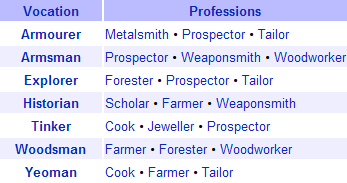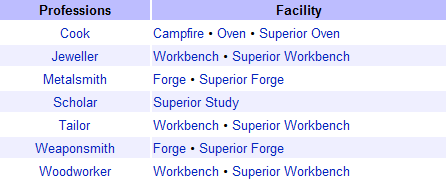Crafting
Getting Started
Making A ChoiceTo start crafting, you must first play through the initial series of quests and move out into the wider world. In various towns throughout Middle-earth, you will find a Master or Mistress of Apprentices who will help you select your vocation. Each vocation is made up of three professions, as shown below. At least one workplace of each type is near each Master or Mistress of Apprentices, so that you can immediately begin crafting. A Provisioner is also nearby, to sell you tools and some of the necessary ingredients.
Spend some time to carefully select your Vocation and its associated professions. Some Professions are very difficult and expensive to advance, while others are very easy. Perhaps the easiest vocation is Explorer because two of the professions (Prospector and Forester) allow gathering of resources and the third (Tailor) requires hides, which are readily available resources.
Easy Professions - Farmer, Prospector, Forester, Cook
Harder Professions - Tailor, Metalsmith, Weaponsmith, Woodworker
Very Hard Professions - Jeweller, Scholar.
Note: A character may change vocations at any time, however you will lose ALL progress and recipes memorized in any profession that is not available in your new vocation. Craft Training
Craft TrainingNear each Master or Mistress of Apprentices, there is a Provisioner and Novice-level Crafting Trainers of all types. The Trainers are stationed at the assorted workplaces that are needed to engage in crafting tasks. Between the Provisioner and the Crafting Trainers of your chosen professions, you can acquire most of the items you need to begin crafting. All crafts require the correct tools, raw materials, and a workplace to perform the task. For instance, woodworking requires a set of woodworking tools, a supply of wood (that can be found throughout your travels in Middleearth), and a workbench. (You receive our initial tools when you choose a profession.) Workbenches are found in many locations in most towns.
Crafting Levels
Each profession is broken up into levels or tiers, and each tier has specific requirements that must be met to advance to the next tier. Every time you create a new item in a given profession, you are rewarded with Crafting Points. After a requisite number of Crafting Points have been earned, you will be rewarded with a new title, and you may find that you need to complete a task — a crafting quest — to advance to the next tier of that profession. To see the different tiers look at the nearby table. After you successfully complete a tier (for example, moved from Apprentice to Journeyman), you will have new crafting actions to try. For example, an Apprentice Prospector can only mine for Tin and Copper. A Journeyman Prospector can also mine for Barrow-iron and Silver. This type of progression continues for all five tiers of each profession.
Completing each tier is not all there is to crafting. Completing the first tier of crafting (from Apprentice to Journeyman), merely demonstrates that you are a Proficient Apprentice. You are not yet a Master in those crafting acts. Your initial Proficiency-level crafting bar (denoted with a brown anvil), has been filled up and a new Mastery-level crafting bar (denoted with a gold anvil) is now available. To achieve Mastery, continue performing the Apprentice crafting actions. For example, using the Prospector from above, you will want to mine for both Barrow Iron to advance your tier and Copper to advance your Apprentice tier toward Mastery.
 Proficiency
ProficiencyYour level of experience is illustrated by anvil icons next to the tier's name. There are two anvil colors; brown representing proficiency and gold representing master.
 An empty, or outlined, anvil indicates that you are currently working towards proficiency.
An empty, or outlined, anvil indicates that you are currently working towards proficiency.
 One filled-in anvil indicates that you have gained proficiency in that tier, but until you master a previous tier you will not gain XP towards mastery in the current tier.
One filled-in anvil indicates that you have gained proficiency in that tier, but until you master a previous tier you will not gain XP towards mastery in the current tier.
 One filled-in anvil and one empty anvil indicate that you have gained proficiency in that tier, and any items crafted at that level will give XP towards mastery of that tier. Note: Once you are proficient in a given tier you will then be able to gain experience in following tier's proficiency level.
One filled-in anvil and one empty anvil indicate that you have gained proficiency in that tier, and any items crafted at that level will give XP towards mastery of that tier. Note: Once you are proficient in a given tier you will then be able to gain experience in following tier's proficiency level.
 Two filled-in anvils indicate that you have completely mastered the tier. Crafting items at that level will not grant any XP. However, every time you craft an item for a tier you have mastered, you have the chance to receive a critical success. See Tier Mastery section, below.
Two filled-in anvils indicate that you have completely mastered the tier. Crafting items at that level will not grant any XP. However, every time you craft an item for a tier you have mastered, you have the chance to receive a critical success. See Tier Mastery section, below.
Mastery After mastering a profession tier, each time you craft an item for that tier, you have the chance to receive a critical success. To access your mastery options there is a mastery tab at the bottom of the crafting window below your recipe ingredients.
The normal critical success rate is 5% chance to create a critical item. There are a couple different outcomes when you produce a successful critical.
- You will produce a larger number of component items. An example would be when a prospector crafts Bronze Ingots they make 2 at a time, but with a critical success they are able to produce 4 ingots.
- You will produce a better quality item with improved stats. An example would be Leather Armour vs. Tough Leather Armour. The mastered item will either have increased stats or more bonuses attached depending on the item and it's crafting level.
- A crafter may increase their critical chance by using higher quality level crafting tools, using crafting lore scrolls (made by a Scholar), or by adding a rare mastery component (most of the time this item is a Trophy). Note: Single-use recipes do not have the option for rare mastery components in the mastery tab. Also, Seed and produce recipes do not have a critical success option.
To view a list of rare mastery components check out the Mastery Components Index (By Profession).
Recipes
In order to craft an item, the crafter must know the recipe. Recipes are either given, purchased, or dropped from treasure or mobs. Each recipe is specific to a profession but most items can be used by someone outside of that profession.
Types of RecipesCrafters use recipes to create various items from the different professions. There are several different types of recipes available to your character.
 Crafting Guilds
Crafting Guilds
Crafting Guilds provide additional paths of advancement for many professions.
Membership in a crafting guild is exclusive - you may only be a member of one crafting guild at a time.
You may choose to join a different crafting guild, but bear in mind that you must abandon all guild recipes and progress gained from your current guild in order to join a new one.
Guild Hall Locations - Cook's Guild - Michel Delving
- Jeweller's Guild - Esteldin
- Metalsmith's Guild - Thorin's Hall
- Scholar's Guild - Rivendell
- Tailor's Guild - Esteldin
- Weaponsmith's Guild - Thorin's Hall
- Woodworker's Guild - Esteldin
The Craft
Recipes require ingredients in order to create items. These ingredients can range from cooking ingredients to mining ore to hides from animals. Some ingredients are used to make components for other item recipes or may be used directly for those items.
Gathering ResourcesCrafting materials are found throughout Middle-earth on Vendors, as loot drops or ground spawns, or in the assorted chests and crates around the world. Raw materials for crafting consist of ores, woods, gems, seeds, cooking supplies, dye components, hides and lore items.
- Ores and woods are most commonly found as ground spawns, and if you have the gathering skill to collect them, you will have a tracking skill that you can activate to give you an indicator when you are near that resource. Ore nodes can also produce gems for Jewellers, minerals used as components for dyes and coal for converting iron ingots into steel ingots.
- Seeds and cooking components can be purchased from Provisioners or tradesmen.
- Hides are found as loot drops from many creatures.
- Lore items are found as loot drops on humanoid enemies or in and around ruins inside ancient artifacts (Shattered Pitcher, Broken Urn, Antique Vase, Forgotten Texts, and Ancient Vase).
All of these assorted materials can also be found in chests scattered throughout the landscape and in dungeons.
Tools and FacilitiesOnce you have chosen your vocation, your first stop should be at the local Provisioner, to buy the tools you will need to begin gathering your necessary raw materials. For some items, many of the raw materials can also be acquired at the Provisioner or a tradesman.
Every profession has a necessary tool that must be equipped on your character sheet to use it, and a necessary place to actually do the work. Professions that produce items (ie: non-gathering) require Crafting Facilities to turn gathered resources into crafted materials and items.







 An empty, or outlined, anvil indicates that you are currently working towards proficiency.
An empty, or outlined, anvil indicates that you are currently working towards proficiency.  One filled-in anvil indicates that you have gained proficiency in that tier, but until you master a previous tier you will not gain XP towards mastery in the current tier.
One filled-in anvil indicates that you have gained proficiency in that tier, but until you master a previous tier you will not gain XP towards mastery in the current tier.  One filled-in anvil and one empty anvil indicate that you have gained proficiency in that tier, and any items crafted at that level will give XP towards mastery of that tier. Note: Once you are proficient in a given tier you will then be able to gain experience in following tier's proficiency level.
One filled-in anvil and one empty anvil indicate that you have gained proficiency in that tier, and any items crafted at that level will give XP towards mastery of that tier. Note: Once you are proficient in a given tier you will then be able to gain experience in following tier's proficiency level.  Two filled-in anvils indicate that you have completely mastered the tier. Crafting items at that level will not grant any XP. However, every time you craft an item for a tier you have mastered, you have the chance to receive a critical success. See Tier Mastery section, below.
Two filled-in anvils indicate that you have completely mastered the tier. Crafting items at that level will not grant any XP. However, every time you craft an item for a tier you have mastered, you have the chance to receive a critical success. See Tier Mastery section, below.


